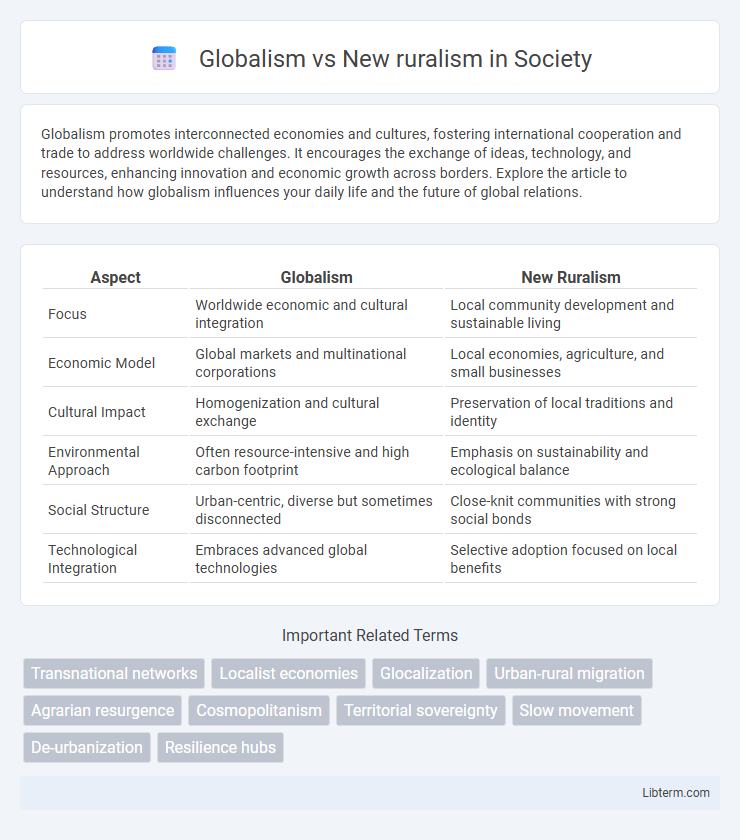Globalism promotes interconnected economies and cultures, fostering international cooperation and trade to address worldwide challenges. It encourages the exchange of ideas, technology, and resources, enhancing innovation and economic growth across borders. Explore the article to understand how globalism influences your daily life and the future of global relations.
Table of Comparison
| Aspect | Globalism | New Ruralism |
|---|---|---|
| Focus | Worldwide economic and cultural integration | Local community development and sustainable living |
| Economic Model | Global markets and multinational corporations | Local economies, agriculture, and small businesses |
| Cultural Impact | Homogenization and cultural exchange | Preservation of local traditions and identity |
| Environmental Approach | Often resource-intensive and high carbon footprint | Emphasis on sustainability and ecological balance |
| Social Structure | Urban-centric, diverse but sometimes disconnected | Close-knit communities with strong social bonds |
| Technological Integration | Embraces advanced global technologies | Selective adoption focused on local benefits |
Understanding Globalism: A Modern Overview
Globalism emphasizes interconnected economies, cultures, and political systems, fostering international trade and global cooperation. It promotes technological advancements, cultural exchange, and the integration of markets to create interdependent societies. The movement supports policies that encourage global governance, free trade agreements, and multinational collaborations aimed at solving worldwide challenges.
Defining New Ruralism: Values and Vision
New Ruralism emphasizes sustainability, community resilience, and local self-reliance, contrasting sharply with the globalism focus on interconnected markets and cosmopolitanism. It advocates for preserving rural heritage, promoting small-scale agriculture, and fostering close-knit social networks to counteract urbanization and economic centralization. This vision champions ecological stewardship and cultural authenticity as core values, aiming to create balanced, thriving rural regions grounded in local identity and environmental care.
Historical Roots of Globalism and New Ruralism
Globalism traces its historical roots to the post-World War II era, characterized by the establishment of international institutions like the United Nations and the Bretton Woods system, which fostered economic integration and cultural exchange across nations. New Ruralism emerges as a response to urbanization and globalization, rooted in late 20th-century movements emphasizing localism, sustainable agriculture, and community resilience. Both ideologies reflect contrasting approaches to economic development and social organization shaped by historical shifts in industrialization and technology.
Economic Impacts: Global Networks vs Local Economies
Globalism fosters interconnected economic networks that enhance trade, investment flows, and access to diverse markets, promoting large-scale economic growth and innovation. New ruralism emphasizes strengthening local economies by supporting small businesses, sustainable agriculture, and community-based enterprises, which helps retain wealth within rural areas and reduces dependency on global supply chains. Economic impacts diverge as globalism maximizes efficiency and market reach, while new ruralism enhances economic resilience and social equity in localized contexts.
Community Identity in a Globalized World
Globalism often challenges community identity by promoting homogenized cultural norms and economic practices that prioritize interconnectedness over local traditions. New ruralism emerges as a response, emphasizing the preservation and revitalization of rural communities through sustainable agriculture, local governance, and cultural heritage. These contrasting paradigms highlight the tension between maintaining unique community identities and adapting to global networks in an increasingly interconnected world.
Environmental Sustainability: Contrasting Approaches
Globalism emphasizes large-scale environmental policies and international cooperation to address climate change, relying on technological innovation and resource redistribution for sustainability. New ruralism advocates for localized, community-driven environmental practices that prioritize ecosystem preservation, biodiversity, and sustainable agriculture. These contrasting approaches reflect a tension between centralized global strategies and decentralized, place-based environmental stewardship.
Technology’s Role: Expanding or Grounding Communities
Technology serves as a double-edged sword in globalism and new ruralism by both expanding connections through digital platforms and grounding communities with localized innovation. In globalism, widespread internet access fuels economic integration and cultural exchange on an international scale. Contrastingly, new ruralism leverages technology for sustainable agriculture, remote work, and digital infrastructure improvements that reinforce community resilience and local identity.
Policy Implications: Governance at Scale and Locally
Globalism advocates for centralized policy frameworks that enable governance at scale, facilitating international cooperation, trade regulations, and standardized economic practices. New ruralism emphasizes decentralized governance, prioritizing local decision-making, community empowerment, and tailored policies that address specific rural development needs. Balancing these approaches requires integrating global standards with local autonomy to optimize policy effectiveness and sustainable growth.
Social Dynamics: Migration, Belonging, and Demographics
Globalism drives increased migration, urbanization, and cultural blending, reshaping social dynamics by fostering diverse, interconnected communities that challenge traditional notions of belonging. New ruralism emphasizes local identity, demographic stabilization, and community cohesion, promoting migration patterns that support rural revitalization and strengthen place-based social bonds. Demographic shifts under globalism tend toward cosmopolitan diversity, while new ruralism seeks to preserve demographic continuity and reinforce localized social structures.
The Future Trajectory: Bridging Globalism and New Ruralism
The future trajectory of globalism and new ruralism hinges on integrating technological advancements with localized community development to foster sustainable economies and resilient social networks. Emphasizing green infrastructure, digital connectivity, and culturally rooted practices can bridge urban-rural divides and address economic disparities. Policymakers and innovators are increasingly exploring hybrid models that leverage global resources while empowering rural autonomy, ensuring equitable growth and environmental stewardship.
Globalism Infographic

 libterm.com
libterm.com